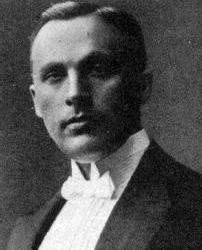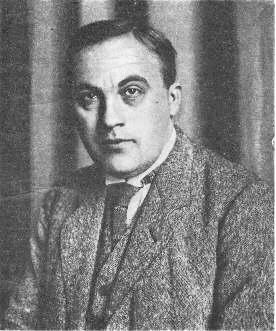GM Efim Bogoljubov

Bio
Efim Bogoljubow was a German grandmaster and world-class player. He is best known for his two matches against Alexander Alekhine for the world championship, but in 1928 he was also the first FIDE champion. Bogoljubow won two consecutive Soviet championships in 1924 and 1925, and won the first German championship in 1933. He is also known for the opening named after him (the Bogo-Indian Defense) and for his famous quote: "When I am White, I win because I am White. When I am Black, I win because I am Bogoljubow."
- Style
- Early Career
- World-Class Player
- World Championship Matches
- Life After The World Championship Matches
- Legacy
Style
Bogoljubow's style was aggressive and tactical, although he was well-rounded in all phases of the game. He was very strong with combinations and had a good feel for sacrifices that had long-lasting benefits. In the following example, Bogoljubow sacrifices a pawn very early to get piece activity—in the final position White has forked Black's rook and queen, and if Black captures the knight, then White wins the queen with Bb5!
Early Career
Bogoljubow was born in Kiev, Russia (now the Ukraine), in 1889. His first serious chess accomplishment occurred when he tied for first place in the Kiev championship in 1911. He made steady progress as a player, and in 1914 he played in the international Mannheim tournament. This tournament was cut short by World War I because war had been declared on Russia. Bogoljubow and ten other Russian masters (including Alekhine) were held in Germany, where he stayed for the rest of the war.
Bogoljubow was allowed to play chess during the war and competed in many tournaments from 1914 to 1916. After the war he won many international tournaments, including victories in Berlin (1919) and Stockholm (1919). In the following game from the Stockholm tournament, Bogoljubow sacrifices a pawn early to create weaknesses on Black's dark squares. He follows the pawn sacrifice with multiple piece sacrifices that ultimately leave Black unable to defend the king.
World-Class Player
In 1922 Bogoljubow finished in first place in the tournament in Bad Pistyan (ahead of Alekhine). In 1923 Bogoljubow shared first through third places in Carlsbad (with Alekhine and Geza Maroczy). At this time he was considered a world-class player, and he returned to Russia for the first time since before World War I.

In 1924 Bogoljubow won the Soviet championship. The year 1925 was one of his best ones, as he won the 1925 Breslau tournament, repeated as Soviet champion and also won the very strong 1925 Moscow tournament (ahead of former world champion Emanuel Lasker, reigning World Champion Jose Capablanca, Frank Marshall, Richard Reti, Akiba Rubinstein and others). In the following game from the Breslau tournament, Bogoljubow sacrifices material to gain an attack on Siegbert Tarrasch's king, which is chased from e8 all the way to d5 before being checkmated!
After his great successes in 1924 and 1925, Bogoljubow was considered a world championship contender. In 1926 he emigrated to Germany and finished in first place at the 1926 Berlin tournament (ahead of Rubinstein),. In 1928 he won the Kissingen tournament (ahead of Capablanca, Aaron Nimzowitsch and other top players), and he defeated the future world champion Max Euwe in the first FIDE Championship match. In late 1928 through 1929 Bogoljubow defeated Euwe again in a 10-game match (the second FIDE Championship).
World Championship Matches
In 1929 Bogoljubow played Alekhine for the world championship. The winner would be the first to 15.5 points in 30 games. Bogoljubow held his own at the start, and after six games the score was tied at 3-3. After game six, Alekhine seemed to step up his play to another level, and Bogoljubow could not stop him. Alekhine won the match by a score of 15.5-9.5 (11 wins, 5 losses, 9 draws).

The following game from the 1929 world championship match that shows that Bogoljubow was a well-rounded player. The game starts rather quietly, and then attacks on each king are made. On move 37, he finds an exchange sacrifice that allows him to enter a winning king-and-pawn endgame.
After the 1929 world championship, Bogoljubow continued to achieve strong tournament results. In 1930 he played for the German team in the Olympiad (earning a silver medal for his performance on board one). In 1933 Bogoljubow won the first German championship, and in 1934 a rematch between Alekhine and Bogoljubow was arranged.
The second world championship match between Alekhine and Bogoljubow was not as well-received as the first one, as a new generation of masters had appeared in the span between 1929 and 1934. Alekhine again won the match convincingly by a score of 15.5-10.5 (8 wins, 3 losses, 15 draws).
Life After The World Championship Matches
Bogoljubow would not play for the world championship again but did continue to have great tournament successes between 1935 and 1940. After World War II started, he continued to play in tournaments in Germany with moderate success. After the war, his play began to decline. In 1951 he won two tournaments and was awarded the title of grandmaster by FIDE. Bogoljubow passed away in the following year.

Legacy
Bogoljubow will always be best remembered for playing Alekhine for the world championship twice, but he will also be remembered for the opening named after him. The Bogo-Indian Defense is still played widely and is the third most popular choice behind the Queen's Indian and Queen's Gambit Declined after 1.d4 Nf6 2.c4 e6 3.Nf3.
Although most of his accomplishments are overshadowed by those of chess giants Capablanca and Alekhine who played during the same time, Bogoljubow remains a chess legend whose games are still studied in books (Garry Kasparov selected 11 games played by Bogoljubow in his five-volume series, My Great Predecessors), videos and articles. He will always be a member of the exclusive group of world-class players who played for the world chess championship as well as the first FIDE champion.


